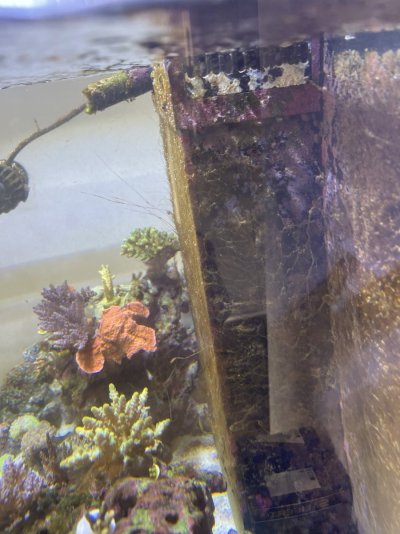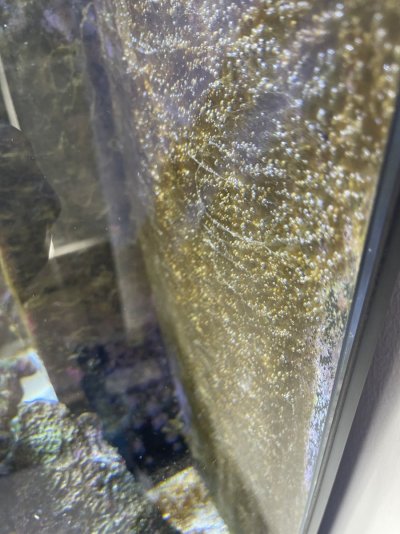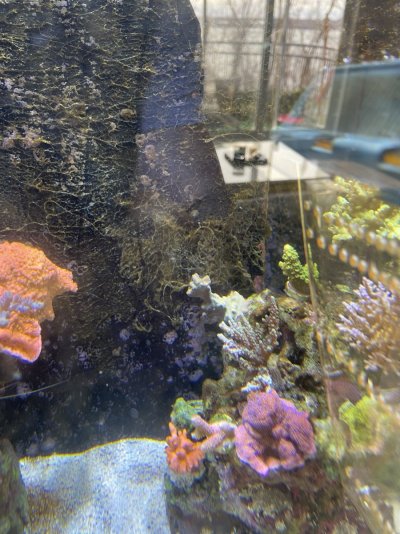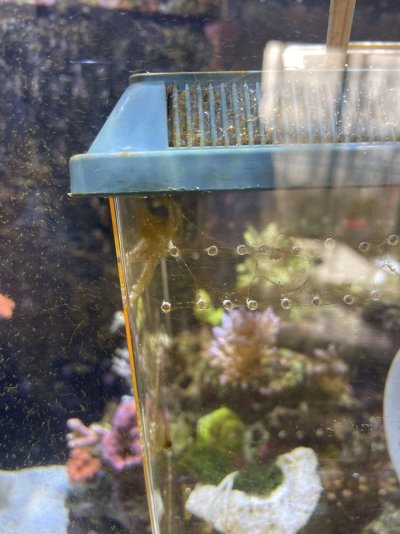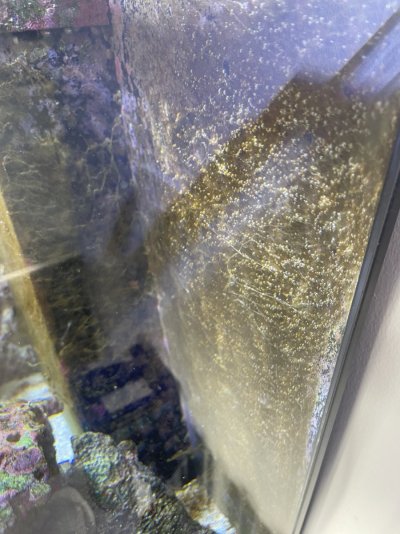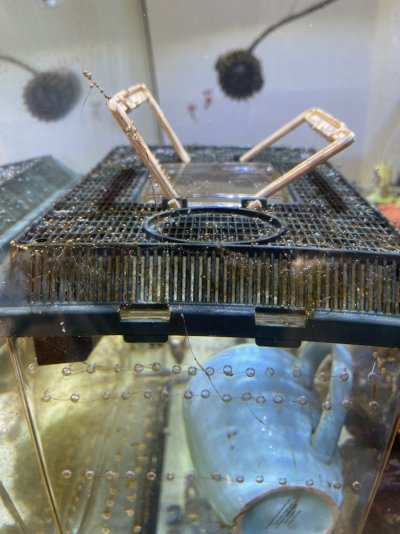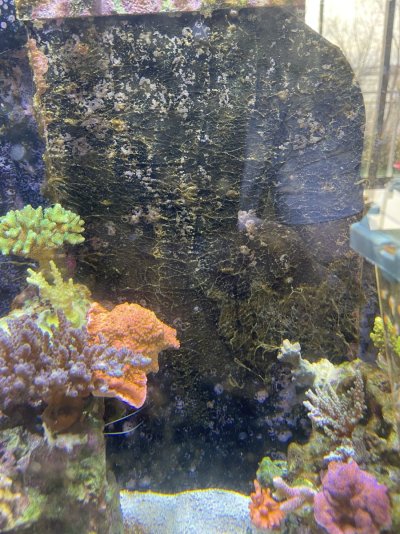Navigation
Install the app
How to install the app on iOS
Follow along with the video below to see how to install our site as a web app on your home screen.
Note: This feature may not be available in some browsers.
More options
You are using an out of date browser. It may not display this or other websites correctly.
You should upgrade or use an alternative browser.
You should upgrade or use an alternative browser.
And my acclimation box has been in for 1 days and it’s already getting covered
- Joined
- Mar 12, 2019
- Messages
- 4,690
- Reaction score
- 3,502
Dinos..get a UV and scrub and vacuum the sand as much as you possibly can, you need to remove as much as you can, and the UV will take care of the dinos you kick up into the water column.
As you have found out, the dinos multiply extremely fast, so you need to do the scrubbing and removal as much as you can.
As you have found out, the dinos multiply extremely fast, so you need to do the scrubbing and removal as much as you can.
ya I’m going to get a uv ,and What you mean as in scrubbing ?Dinos..get a UV and scrub and vacuum the sand as much as you possibly can, you need to remove as much as you can, and the UV will take care of the dinos you kick up into the water column.
As you have found out, the dinos multiply extremely fast, so you need to do the scrubbing and removal as much as you can.
- Joined
- Mar 12, 2019
- Messages
- 4,690
- Reaction score
- 3,502
The rocks, it needs removing, as the uv can’t help with dinos that is on rocks or on the sand.ya I’m going to get a uv ,and What you mean as in scrubbing ?
Okok will do that, should I do a black out ?The rocks, it needs removing, as the uv can’t help with dinos that is on rocks or on the sand.
- Joined
- Mar 12, 2019
- Messages
- 4,690
- Reaction score
- 3,502
No need, that is a last resort and if you can’t get rid of them without a blackout its because you have not tried hard enough, pull the rocks out and scrub in old tank water, you will be shocked at how much comes of them.Okok will do that, should I do a black out ?
Worth making sure at night that the tank is dark, I actually wrap mine in a blackout blind, its for the fish to sleep but it will help the dinos that feed on light, leave the sand and rocks and go into the UV, but not all dinos go into the water column at night, this is a reason why a backout is not the answer.
Last edited:
Dinos..get a UV and scrub and vacuum the sand as much as you possibly can, you need to remove as much as you can, and the UV will take care of the dinos you kick up into the water column.
As you have found out, the dinos multiply extremely fast, so you need to do the scrubbing and removal as much as you can.
UV only helps with a specific kind of dino
The rocks, it needs removing, as the uv can’t help with dinos that is on rocks or on the sand.
Again, that depends on the type of dino. The dino that is killed off by UV goes into the water column at night
- Joined
- Mar 12, 2019
- Messages
- 4,690
- Reaction score
- 3,502
It helps with all dinos if they go through the UV! that is what the scrubbing and vacuuming of the sand is for.UV only helps with a specific kind of dino
Only this is a disaster, should I remove carbon ? Or keep it ?It helps with all dinos if they go through the UV! that is what the scrubbing and vacuuming of the sand is for.
And lower my fuge light ?Only this is a disaster, should I remove carbon ? Or keep it ?
- Joined
- Mar 12, 2019
- Messages
- 4,690
- Reaction score
- 3,502
Keep it and replace it often.Only this is a disaster, should I remove carbon ? Or keep it ?
As long as your nutrients are not too low, you can leave it alone…you will see a huge improvement after a couple of days but you need to keep at it for a couple of weeks, once you see an improvement you can start to add pods, bottled bacteria, phyto, not one measure will get rid of dinos you need to hit them on a few different angles.
Reefer Matt
Reef Cave Dweller
View Badges
Partner Member 2024
Excellence Award
RGB
R2R Media Partner
Hospitality Award
R2R Secret Santa 2023
My Tank Thread
My Aquarium Showcase
I would get a microscope to be sure. Even if it is dino, there are different species that require different remedies.
UV doesn’t work with prorocentrum. And maybe SCA, not sure.It helps with all dinos if they go through the UV! that is what the scrubbing and vacuuming of the sand is for.
You need to dose sodium silicate with prorocentrum.
It sure looks like Dinos. I had a long battle with them years ago in my 200 SPS tank that I lost. I learned a lot of hard lessons. More recently I had them in my 30 gallon QT. The lesson is that in the first rank I panicked, made bad decisions and lost. In the second outbreak I was calm and patient and ultimately got rid of them.
My mistakes:
Read lots of posts and tried many fixes.
1. Lights out and wrap tank: brief respite but came right back
2. Ran UV: no effect
3. Siphoned out all Dino’s possible through filter floss and returned water: (dirty water theory) they pass right through filter floss: no effect
4. Used Dino X: killed virtually everything in tank
Almost quit hobby, then rebooted whole system:
Set up ozone system, used peroxide, added unwashed live sand (bacteria competitive inhibition) siphoned and discarded Dino’s everyday. Not sure what part worked but tank has been Dino free since
In 30 gallon tank, immediately opted for peroxide, but didn’t work on its own so don’t think that’s what fixed the 200. Chose to be patient and just siphon and discard everyday. It took awhile but the tank is clear
In retrospect I think it’s a matter of competition and nutrient availability. My big tank outbreak came after dosing a cyano treatment. I killed the bacteria and the Dino’s took advantage and bloomed. Unwashed live sand in small amounts or direct bacteria dosing might aid in getting bacterial competitors for nutrients.
Daily siphoning is best. Think of it as nutrient export. The Dino’s are taking in some essential nutrient in the system. Every day you siphon them out you reduce that nutrient. Overtime you will succeed but it may take weeks. The good news is Dino’s are easy to siphon. You can also remove detritus, and algae as well and tank will start looking pretty good
My mistakes:
Read lots of posts and tried many fixes.
1. Lights out and wrap tank: brief respite but came right back
2. Ran UV: no effect
3. Siphoned out all Dino’s possible through filter floss and returned water: (dirty water theory) they pass right through filter floss: no effect
4. Used Dino X: killed virtually everything in tank
Almost quit hobby, then rebooted whole system:
Set up ozone system, used peroxide, added unwashed live sand (bacteria competitive inhibition) siphoned and discarded Dino’s everyday. Not sure what part worked but tank has been Dino free since
In 30 gallon tank, immediately opted for peroxide, but didn’t work on its own so don’t think that’s what fixed the 200. Chose to be patient and just siphon and discard everyday. It took awhile but the tank is clear
In retrospect I think it’s a matter of competition and nutrient availability. My big tank outbreak came after dosing a cyano treatment. I killed the bacteria and the Dino’s took advantage and bloomed. Unwashed live sand in small amounts or direct bacteria dosing might aid in getting bacterial competitors for nutrients.
Daily siphoning is best. Think of it as nutrient export. The Dino’s are taking in some essential nutrient in the system. Every day you siphon them out you reduce that nutrient. Overtime you will succeed but it may take weeks. The good news is Dino’s are easy to siphon. You can also remove detritus, and algae as well and tank will start looking pretty good
You have a link on what kind of micro scope I can get ?I would get a microscope to be sure. Even if it is dino, there are different species that require different remedies.
- Joined
- Mar 12, 2019
- Messages
- 4,690
- Reaction score
- 3,502
Of course it does, UV would work with me if I went through it lol…as in my posts above, I said as much myself, some dinos do not leave the rocks or sand, I said that, that is why I recommended multiple ways…silicate is only going to help produce diatoms, which takes up the space the dinos were occupying when you remove them, that is why I recommend bacteria which also does the same thing.UV doesn’t work with prorocentrum. And maybe SCA, not sure.
You need to dose sodium silicate with prorocentrum.
Maybe try and help the OP instead of picking at my posts, I’m happy to reply to your points but it’s a little rude to the op that is trying to get help.
Last edited:
Holy this is going to be a battleIt sure looks like Dinos. I had a long battle with them years ago in my 200 SPS tank that I lost. I learned a lot of hard lessons. More recently I had them in my 30 gallon QT. The lesson is that in the first rank I panicked, made bad decisions and lost. In the second outbreak I was calm and patient and ultimately got rid of them.
My mistakes:
Read lots of posts and tried many fixes.
1. Lights out and wrap tank: brief respite but came right back
2. Ran UV: no effect
3. Siphoned out all Dino’s possible through filter floss and returned water: (dirty water theory) they pass right through filter floss: no effect
4. Used Dino X: killed virtually everything in tank
Almost quit hobby, then rebooted whole system:
Set up ozone system, used peroxide, added unwashed live sand (bacteria competitive inhibition) siphoned and discarded Dino’s everyday. Not sure what part worked but tank has been Dino free since
In 30 gallon tank, immediately opted for peroxide, but didn’t work on its own so don’t think that’s what fixed the 200. Chose to be patient and just siphon and discard everyday. It took awhile but the tank is clear
In retrospect I think it’s a matter of competition and nutrient availability. My big tank outbreak came after dosing a cyano treatment. I killed the bacteria and the Dino’s took advantage and bloomed. Unwashed live sand in small amounts or direct bacteria dosing might aid in getting bacterial competitors for nutrients.
Daily siphoning is best. Think of it as nutrient export. The Dino’s are taking in some essential nutrient in the system. Every day you siphon them out you reduce that nutrient. Overtime you will succeed but it may take weeks. The good news is Dino’s are easy to siphon. You can also remove detritus, and algae as well and tank will start looking pretty good
Reefer Matt
Reef Cave Dweller
View Badges
Partner Member 2024
Excellence Award
RGB
R2R Media Partner
Hospitality Award
R2R Secret Santa 2023
My Tank Thread
My Aquarium Showcase
Here's the one I use. I works great for me to identify problem algae, etc. it saves the headache of guessing and trying different things. Slides and slide covers are needed too.You have a link on what kind of micro scope I can get ?
SWIFT Compound Monocular Microscope SW200DL with 40X-1000X Magnification, Dual Light, Precision Fine Focus, Wide-Field 25X Eyepiece and Cordless Capability for Student Beginner https://a.co/d/7J7ttCO
Similar threads
- Replies
- 8
- Views
- 94
- Replies
- 47
- Views
- 650


